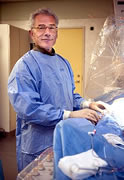
|
Q: When did you first think of doing coronary interventions from the radial artery? Then I started to discuss with Patrick Serruys the use of the Palmaz-Schatz stent not as a bailout device, but as a device to prevent restenosis. That was actually the premise of the BENESTENT study. So we started to stent on a more regular basis, but we had a problem with those fully anticoagulated patients who had Coumadin, dextran, heparin, persantine, aspirin. Everything we could find to block the coagulation system, we just gave to the patient. And we had the groin prepared with an 8F sheath, sometime 9F even. So we had this difficult balance between sheath removal and hemostasis and that could last maybe a day, two days, sometimes three days, before we had the proper balance between the patient being adjusted on Coumadin, we could lower heparin, and then we could retrieve the sheath. But despite all those precautions, we saw groin hematoma develop. These were very hard to handle under anticoagulation, especially in the more obese and older patients. Usually a groin complication also resulted in a coronary complication because you had to reverse anticoagulation and the patient was hypotensive. Also in that time the stents were not properly deployed; we did not do routine ultrasound, IVUS, which was Antonio Colombo's great contribution. So, actually, we lost some patients' lives. The Board of Directors in my hospital urged me to find some solution for this because otherwise I had to stop the whole stent program. But then, as a gift from heaven, came Campeau's paper in 1989 in Catheterization and Cardiovascular Diagnosis: 100 patients that he had angiographed via the radial artery with 5F catheters. I'd never heard of that before, so when I read that article, actually a very modest and short article, I was impressed. If you can reach the coronary artery via the radial artery, and why shouldn't you, instead of just injecting contrast, also advance a wire and a balloon and maybe a stent; that would solve the whole problem [of hematomas] just based on the anatomical characteristics of the radial artery.
I took the Grey's Anatomy from 1948 from my father and I saw a couple of pictures, those beautiful drawings, of the forearm, the radial artery, and you could see that based on the characteristics of the radial artery, it is in effect surrounded by bony structures, together with the Palmar arches. Altogether that meant for me this is a safe place and, if you have bleeding, it's easy to control. You can just remove the sheath immediately, and if something happens the patient can even handle the problem himself. In the groin, if you lose blood, it takes half an hour or an hour before you notice. But in the wrist, it's immediately evident. So that actually was kind of a dream that I had based on this publication. Wow, if we have stents that are compatible with the radial artery diameter.... Don't forget at the time we had a stent delivery system from J&J that was quite a bulky device - so we had to rip off the stents from the balloon and crimp them on smaller balloons, and it took a couple of years before we got 6F guides available and that was in '92. Then we started to do the first PCIs from the radial artery, but the reason was to reduce bleeding concerns during coronary stenting. Q: So the initial impulse to use the radial artery came out of a concern for safety? Q: You were talking about equipment and the fact that the catheter systems were so bulky. Part of the spread of the transradial approach, as well as other interventional procedures, has to do with better equipment. At that time, 6F guides were absolutely not popular because during stenting you really needed to have enormous backup support of your guides. Also, visualization and retrieval of the stent systems. Those stents were manually crimped on the balloon. Suppose your stent failed to open the lesion? Then you had to draw the whole system back into the guide. With a 6F guide, it easily could happen that the stent slipped off the balloon, leaving the undeployed stent in the coronary artery. So, all those issues together, backup support, the small inner lumen, the risk for stent loss, gave rise to a discussion whether or not to use 6F guides for stenting at all. But 6F guides became better and better. Their inner lumen became better, there was better backup support, you had dedicated catheters for radial. Softer tips, more flexible tips, stiffer primary and secondary curves to increase support, etc. So there was a lot of work spent in developing better guides. That's one. Then, of course, the stent delivery systems were getting better. In the early years you would just buy a box of Palmaz-Schatz stents without balloons, just to crimp them on your own balloons. But later, you had stent delivery systems without the sheath, just the stent crimped on the balloon, done in the manufacturing plants. So we did not have to do that ourselves, with all the limitations. And stent balloons were getting smaller and smaller. So altogether it became easier to get stents implanted through 6F guides. Q: Tell me about the first transradial PCIs? But later in '94, we got the first international exposure of TRI via a beautiful live demonstration of Jean Fajadet, who just a couple of weeks before visited our hospital and saw the patients walking from the table immediately after stenting, and said, "That's something I want to show in two weeks during the TCT!" I was very nervous about that because I had two years experience and he had no experience at the time that he proposed this. But he did a beautiful case two weeks later from Toulouse, and he initiated a lot of international attention. From then on, the medical industry began to focus on dedicated TRI equipment. Terumo was very early, also Cordis and Cook and Arrow are some early names that developed dedicated needles, dedicated sheaths, and that's an improvement which is still continuing.
But I think that the latest developments are found in the Slender Club, which is a group of Japanese TRI adepts. They're quite fanatic in downsizing and miniaturization to the absolute limits, 3F coronary angiography, sheathless 4F PCI. Saito calls that "Virtual 2F." And this is a very active group: they meet several times per year and they challenge each other to show the most complex cases via most downsized systems. You can't imagine the complexity of the cases that they are doing with miniaturized materials, and I have the impression that the Japanese companies are very actively developing materials for this Club. So, from that corner of the world, we are getting from Japan, I think, the best materials at the moment, the best guides, the best wires, the best balloon systems, the best stent systems, it's really quite impressive what they are doing. Q: Speaking of international spread, while the U.S. is gaining in acceptance of transradial, it's still well behind everybody else. Q: We talked about the wide variability in where TRI is practiced. Why is that? It's not easy. Femoral approach is technically a lot easier. Personally, I was surprised by the problems you could encounter during a transradial PCI. Getting to the coronaries is sometimes already quite a procedure. You have to cope with tortuosity, maybe some narrowings, calcifications, spasm. But, with routine, everything gets easier, and a fast and a smooth procedure will be noticed by the patient. I understand that in the United States there are some very small practices that do 50 or 100 PCIs per year. I don't think you can ever be successful if you are doing a few PCIs per year by the radial. I'm sure of that. Q: But once TRI becomes easier to do, when it becomes routine, isn't it also safer? Q: I'd like to talk about complications. Of course, there are well-documented complications with the femoral approach -- this is unfortunately one of the most popular topics in our Patient Forum. Q: A lot of times, they don't see them, because the complications are dealt with by someone else, for example the Emergency Dept. Q: What's the biggest complication in radial artery access in today's practice and what's your advice on avoiding it?
But I think personally the biggest enemy for TRI is radial artery occlusion. Suppose everyone is going to take the radial artery as the default route, and patients are coming back 2, 3, 4, 5, 6 times for staged procedures, coronary angiography, repeat procedures, a control, another vessel. So the radial artery is used multiple times. That might result in radial artery occlusion in the end. If you don't take good care of the radial artery, then maybe ten years from now, in an important percentage of your daily interventional practice, you might see patients with occluded radial arteries, so you have to take another artery, or the left radial artery, or even the groin. I'm not saying that is going to happen, but it is a concern. I don't know if radial artery occlusion is underreported, we thought it was around 3%. Early occlusions were higher, around 10%, but a lot of radial artery occlusions recanalize spontaneously. Still, 3% is 3%, and if you don't take proper care, that might be higher. So if we want to continue to give the safest strategy to the patient, which in my view is still TRI in terms of prevention of bleeding, then we should guarantee to patients that they end up with a patent radial artery; the artery is theirs, it is not the doctor's! There are ways to prevent radial artery occlusion, proper heparinization for example, is one -- also good hemostasis technique, it's called patent hemostasis, where you do not block the radial artery for a long time just to get hemostasis, but gentle compression, everything gentle. Q: I made up a rhyme about that: "Too Long, Too Strong For Radial is Wrong."
|




